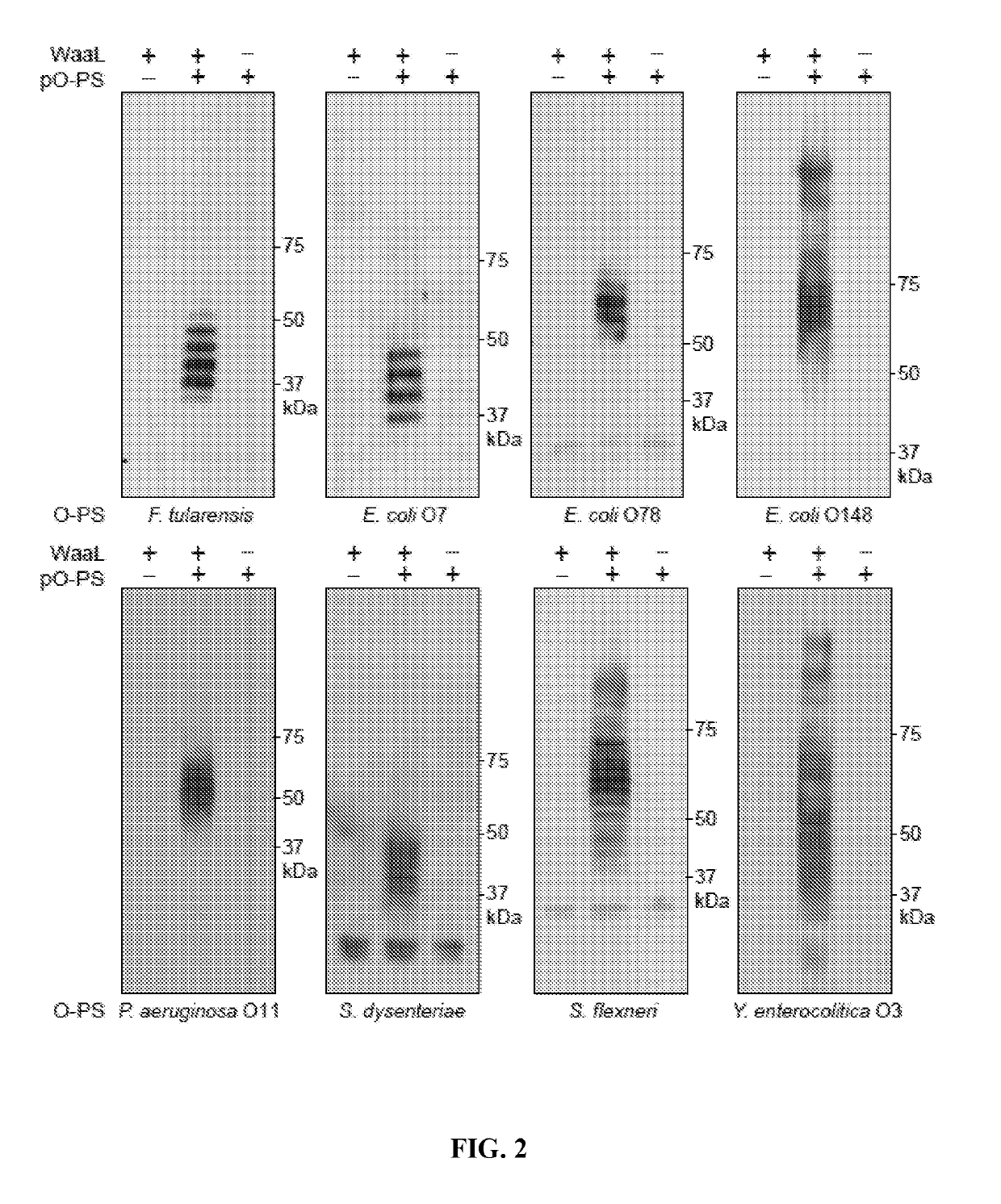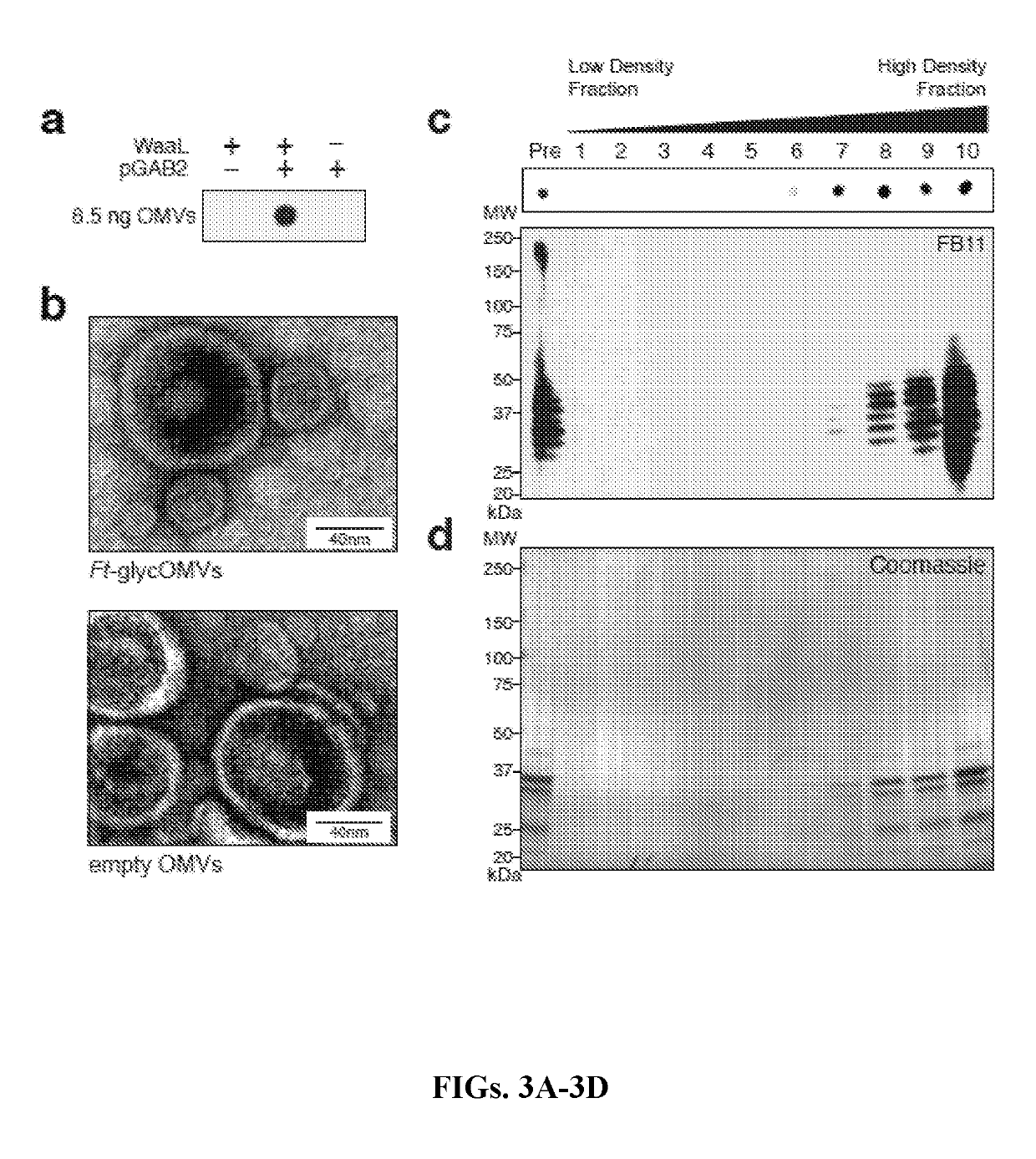Compositions and methods for the expression of eukaryotic oligosaccharides on bacterial outer membrane vesicles
a technology of bacterial outer membrane and eukaryotic oligosaccharides, which is applied in the direction of antibody medical ingredients, peptide sources, carrier-bound antigen/hapten ingredients, etc., can solve the problems of difficult scaling, high labor intensity of techniques, and difficult to isolate glycan-based immunogens from cells and tissues, etc., to improve the innate immune response, low dose of infection, and high fatality ra
- Summary
- Abstract
- Description
- Claims
- Application Information
AI Technical Summary
Benefits of technology
Problems solved by technology
Method used
Image
Examples
example 1
brane Vesicles Displaying Engineered Glycotopes Elicit Protective Antibodies
Materials and Methods
[0130]Bacterial Strains and Plasmids.
[0131]The bacterial strains and plasmids used in this study are described in Table 1. Briefly, E. coli strain JC8031, a tolRA mutant strain that is known to hypervesiculate (Bernadac et al., “Escherichia coli Tol-Pal Mutants Form Outer Membrane Vesicles,”J. Bacteriol. 180:4872-4878 (1998), which is hereby incorporated by reference in its entirety), was used for preparation of OMVs. Strain CE8032, a waaL::Kan mutant derived from JC8031, was used as a control (Fisher et al., “Production of Secretory and Extracellular N-linked Glycoproteins in Escherichia coli,” Appl Environ Microbiol 77:871-881 (2011), which is hereby incorporated by reference in its entirety). Strain JH8033 was generated from JC8031 using P1 transduction of the lpxM::kan allele from the Keio collection as described in previous work (Rosenthal et al., “Mechanistic Insight into the TH1-b...
example 2
ion with Outer Membrane Vesicles Displaying Designer Glycotopes Yields Class-Switched, Glycan-Specific Antibodies
Materials and Methods
[0190]Bacterial Strains and Plasmids.
[0191]A description of all bacterial strains and plasmids used in this study, including those that were constructed herein, is provided in Table 5 below.
TABLE 5Bacterial Strains and Plasmids Used in This StudyStrain or plasmidGenotype / DescriptionSourceStrains1292supE hsdS met gal lacY tonA(Bernadac et al., 1998)1JC80311292 ΔtolRA(Bernadac et al., 1998)1JC8032JC8031 ΔwaaL::KanThis studyJC8033JC8031 ΔnanAThis studyJC8034JC8033 ΔwaaL::KanThis studyJC8035JC8033 ΔwecA::KanThis studyMC4100F− araD139 Δ(argF-lac)U169 rpsL150 (StrR) relA1Lab stockfibB5301 deoC1 ptsF25 rbsRMC4100 ΔwaaL::KanMC4100 ΔwaaL::KanThis studyEV36K-12 / K1 hybrid(Vimr et al., 1989)2MG1655F−λ− ilvG− rfb-50 rph-1Lab stockMG1655-vesMG1655 ΔnlPIThis studyClearColi K-12ΔgutQ ΔkdsD ΔlpxL ΔlpxM ΔpagP ΔlpxP ΔeptA msbA148(Mamat et al., 2008)3ClearColi-vesClearCo...
example 3
ous Expression of Surface-Displayed Eukaryotic Lewis-Type Glycan Structures
[0234]Preparing Glycan Biosynthetic Pathways.
[0235]Lewis glycan structures have been identified in a number of studies as carbohydrates that are ectopically expressed in certain cancers, and it has been reported that antibodies recognizing these structures can have clinical benefits in cancer treatment. As described below, genetic pathways were engineered for the display of Lewis glycans on the surface of E. coli for incorporation in OMVs.
[0236]To prepare a bacterial expression system for the Lewis X- and Lewis Y-based glycan structures, a plasmid was first generated for assembly of the shared carbohydrate backbone consisting of the trisaccharide: β-Gal-(1→4)-β-GlcNAc-(1→3)-β-Gal-(1→4)-. The low copy number vector pMW07 was used, and employed homologous recombination in yeast to create an operon encoding LgtA (β 1,3-N-acetylglucosyaminyl transferase from N. meningitidis), LgtE (β1,4-galactosyltransferase from...
PUM
| Property | Measurement | Unit |
|---|---|---|
| time | aaaaa | aaaaa |
| concentration | aaaaa | aaaaa |
| pH | aaaaa | aaaaa |
Abstract
Description
Claims
Application Information
 Login to View More
Login to View More - R&D
- Intellectual Property
- Life Sciences
- Materials
- Tech Scout
- Unparalleled Data Quality
- Higher Quality Content
- 60% Fewer Hallucinations
Browse by: Latest US Patents, China's latest patents, Technical Efficacy Thesaurus, Application Domain, Technology Topic, Popular Technical Reports.
© 2025 PatSnap. All rights reserved.Legal|Privacy policy|Modern Slavery Act Transparency Statement|Sitemap|About US| Contact US: help@patsnap.com



